Reward and Performance Report - CIPD R104-5C001, May 2022 Assessment
VerifiedAdded on 2023/01/13
|25
|6093
|71
Report
AI Summary
This report, submitted as part of a CIPD assessment, explores the multifaceted aspects of reward and performance management within organizations. Task One delves into the impact of reward approaches and packages, examining principles such as fairness, consistency, equity, and transparency. It analyzes the implementation of reward policies, the influence of people and organizational performance on reward strategies, and the merits of various benefits, including extrinsic and intrinsic rewards. The report further investigates benchmarking data to inform reward approaches, covering business context, data gathering, and legislative requirements. Task Two focuses on performance management approaches, the role of people practices in supporting line managers, and how managers make reward judgments. The report incorporates figures and references to support its findings, demonstrating a comprehensive understanding of reward systems and their contribution to organizational culture and performance.
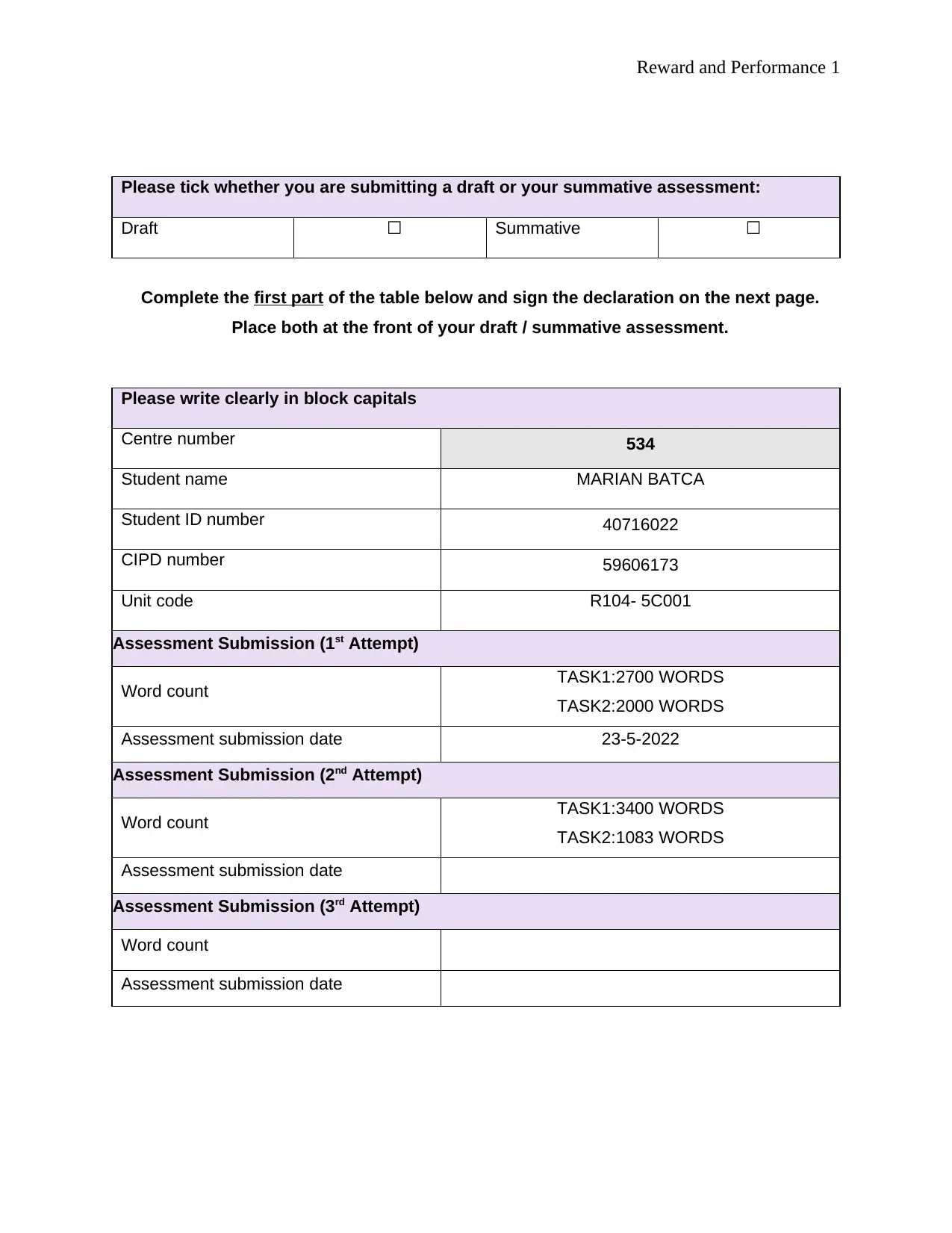
Reward and Performance 1
Please tick whether you are submitting a draft or your summative assessment:
Draft ☐ Summative ☐
Complete the first part of the table below and sign the declaration on the next page.
Place both at the front of your draft / summative assessment.
Please write clearly in block capitals
Centre number 534
Student name MARIAN BATCA
Student ID number 40716022
CIPD number 59606173
Unit code R104- 5C001
Assessment Submission (1st Attempt)
Word count TASK1:2700 WORDS
TASK2:2000 WORDS
Assessment submission date 23-5-2022
Assessment Submission (2nd Attempt)
Word count TASK1:3400 WORDS
TASK2:1083 WORDS
Assessment submission date
Assessment Submission (3rd Attempt)
Word count
Assessment submission date
Please tick whether you are submitting a draft or your summative assessment:
Draft ☐ Summative ☐
Complete the first part of the table below and sign the declaration on the next page.
Place both at the front of your draft / summative assessment.
Please write clearly in block capitals
Centre number 534
Student name MARIAN BATCA
Student ID number 40716022
CIPD number 59606173
Unit code R104- 5C001
Assessment Submission (1st Attempt)
Word count TASK1:2700 WORDS
TASK2:2000 WORDS
Assessment submission date 23-5-2022
Assessment Submission (2nd Attempt)
Word count TASK1:3400 WORDS
TASK2:1083 WORDS
Assessment submission date
Assessment Submission (3rd Attempt)
Word count
Assessment submission date
Paraphrase This Document
Need a fresh take? Get an instant paraphrase of this document with our AI Paraphraser
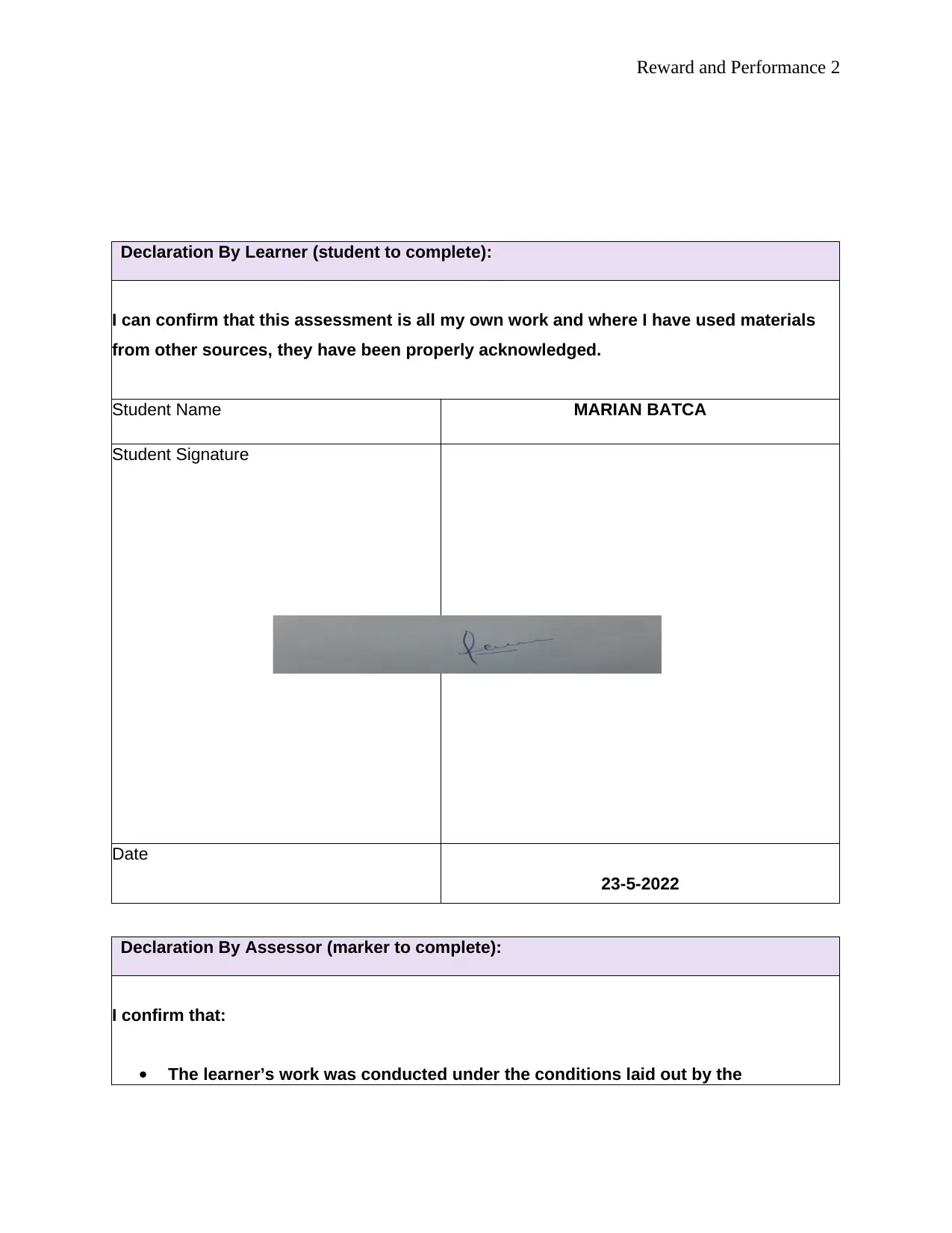
Reward and Performance 2
Declaration By Learner (student to complete):
I can confirm that this assessment is all my own work and where I have used materials
from other sources, they have been properly acknowledged.
Student Name MARIAN BATCA
Student Signature
Date
23-5-2022
Declaration By Assessor (marker to complete):
I confirm that:
The learner’s work was conducted under the conditions laid out by the
Declaration By Learner (student to complete):
I can confirm that this assessment is all my own work and where I have used materials
from other sources, they have been properly acknowledged.
Student Name MARIAN BATCA
Student Signature
Date
23-5-2022
Declaration By Assessor (marker to complete):
I confirm that:
The learner’s work was conducted under the conditions laid out by the
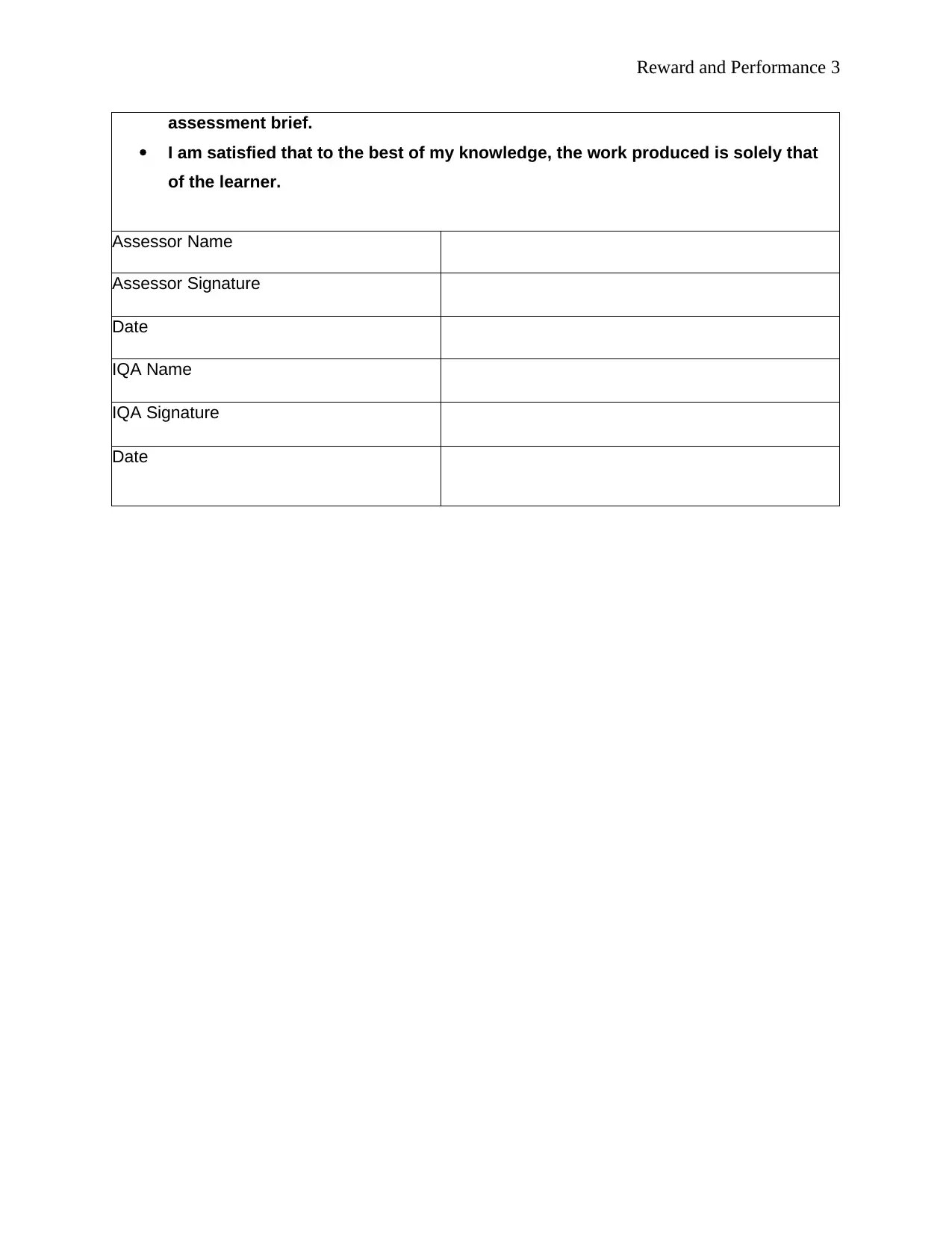
Reward and Performance 3
assessment brief.
I am satisfied that to the best of my knowledge, the work produced is solely that
of the learner.
Assessor Name
Assessor Signature
Date
IQA Name
IQA Signature
Date
assessment brief.
I am satisfied that to the best of my knowledge, the work produced is solely that
of the learner.
Assessor Name
Assessor Signature
Date
IQA Name
IQA Signature
Date
⊘ This is a preview!⊘
Do you want full access?
Subscribe today to unlock all pages.

Trusted by 1+ million students worldwide
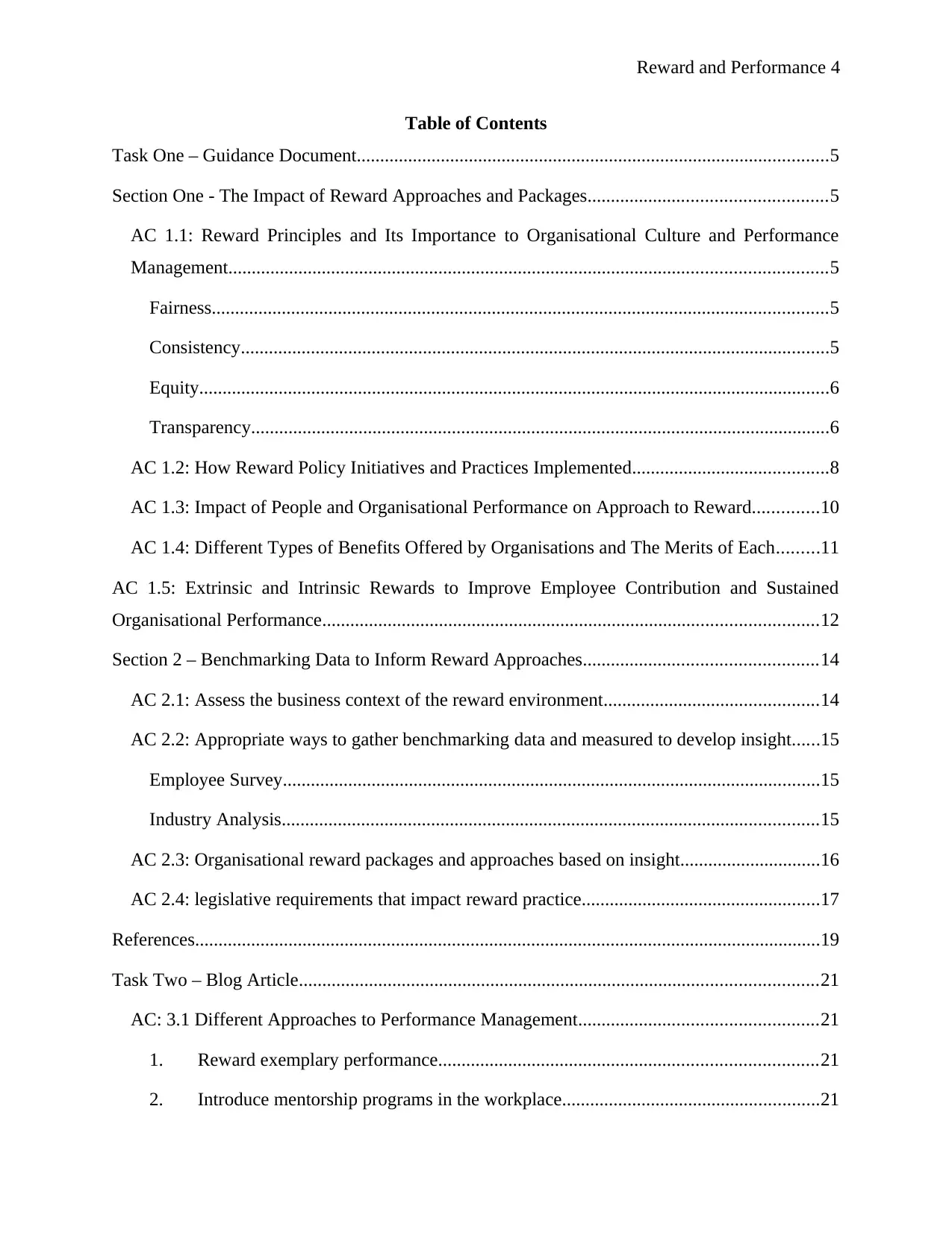
Reward and Performance 4
Table of Contents
Task One – Guidance Document.....................................................................................................5
Section One - The Impact of Reward Approaches and Packages...................................................5
AC 1.1: Reward Principles and Its Importance to Organisational Culture and Performance
Management................................................................................................................................5
Fairness....................................................................................................................................5
Consistency..............................................................................................................................5
Equity.......................................................................................................................................6
Transparency............................................................................................................................6
AC 1.2: How Reward Policy Initiatives and Practices Implemented..........................................8
AC 1.3: Impact of People and Organisational Performance on Approach to Reward..............10
AC 1.4: Different Types of Benefits Offered by Organisations and The Merits of Each.........11
AC 1.5: Extrinsic and Intrinsic Rewards to Improve Employee Contribution and Sustained
Organisational Performance..........................................................................................................12
Section 2 – Benchmarking Data to Inform Reward Approaches..................................................14
AC 2.1: Assess the business context of the reward environment..............................................14
AC 2.2: Appropriate ways to gather benchmarking data and measured to develop insight......15
Employee Survey...................................................................................................................15
Industry Analysis...................................................................................................................15
AC 2.3: Organisational reward packages and approaches based on insight..............................16
AC 2.4: legislative requirements that impact reward practice...................................................17
References......................................................................................................................................19
Task Two – Blog Article...............................................................................................................21
AC: 3.1 Different Approaches to Performance Management...................................................21
1. Reward exemplary performance.................................................................................21
2. Introduce mentorship programs in the workplace.......................................................21
Table of Contents
Task One – Guidance Document.....................................................................................................5
Section One - The Impact of Reward Approaches and Packages...................................................5
AC 1.1: Reward Principles and Its Importance to Organisational Culture and Performance
Management................................................................................................................................5
Fairness....................................................................................................................................5
Consistency..............................................................................................................................5
Equity.......................................................................................................................................6
Transparency............................................................................................................................6
AC 1.2: How Reward Policy Initiatives and Practices Implemented..........................................8
AC 1.3: Impact of People and Organisational Performance on Approach to Reward..............10
AC 1.4: Different Types of Benefits Offered by Organisations and The Merits of Each.........11
AC 1.5: Extrinsic and Intrinsic Rewards to Improve Employee Contribution and Sustained
Organisational Performance..........................................................................................................12
Section 2 – Benchmarking Data to Inform Reward Approaches..................................................14
AC 2.1: Assess the business context of the reward environment..............................................14
AC 2.2: Appropriate ways to gather benchmarking data and measured to develop insight......15
Employee Survey...................................................................................................................15
Industry Analysis...................................................................................................................15
AC 2.3: Organisational reward packages and approaches based on insight..............................16
AC 2.4: legislative requirements that impact reward practice...................................................17
References......................................................................................................................................19
Task Two – Blog Article...............................................................................................................21
AC: 3.1 Different Approaches to Performance Management...................................................21
1. Reward exemplary performance.................................................................................21
2. Introduce mentorship programs in the workplace.......................................................21
Paraphrase This Document
Need a fresh take? Get an instant paraphrase of this document with our AI Paraphraser
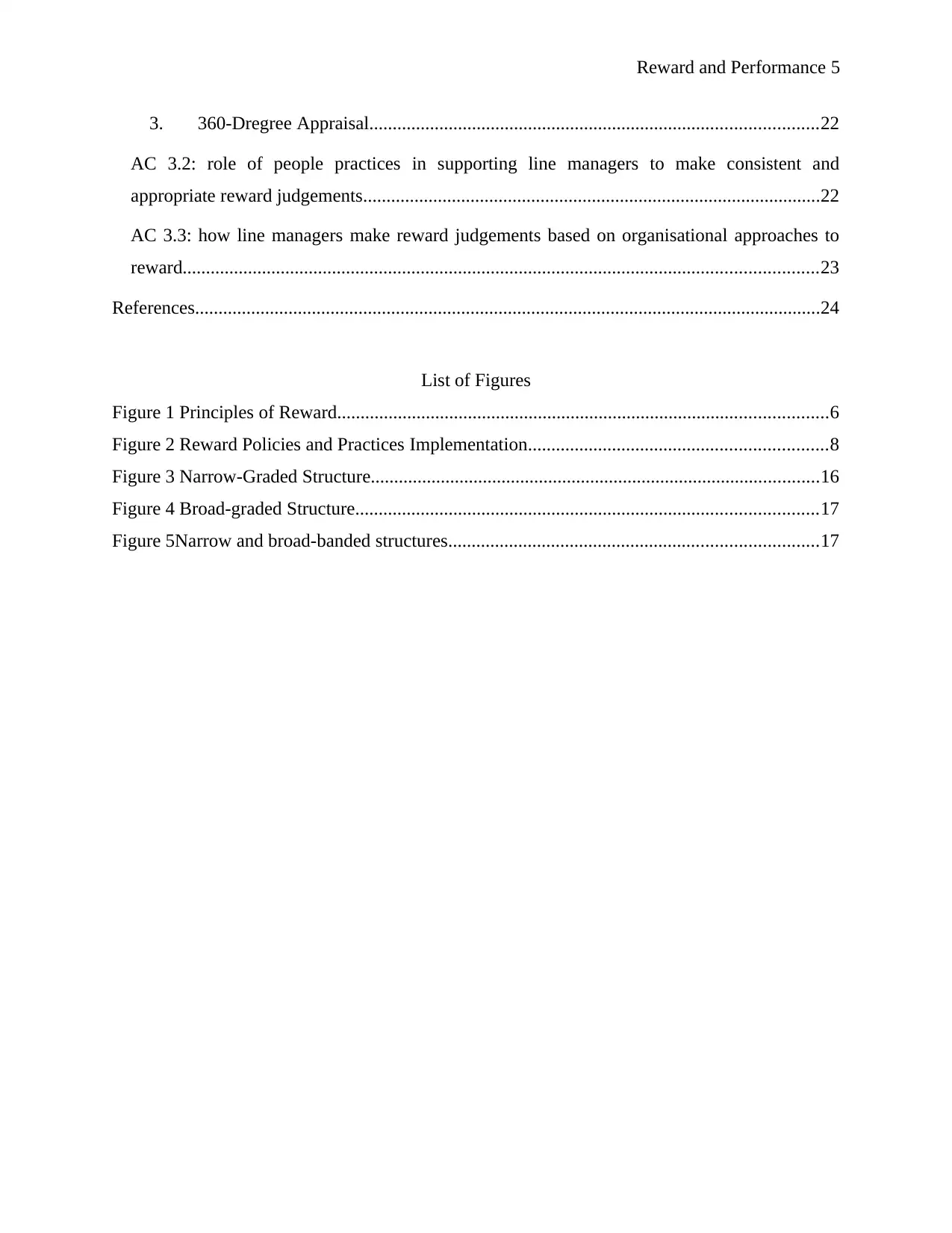
Reward and Performance 5
3. 360-Dregree Appraisal................................................................................................22
AC 3.2: role of people practices in supporting line managers to make consistent and
appropriate reward judgements..................................................................................................22
AC 3.3: how line managers make reward judgements based on organisational approaches to
reward........................................................................................................................................23
References......................................................................................................................................24
List of Figures
Figure 1 Principles of Reward.........................................................................................................6
Figure 2 Reward Policies and Practices Implementation................................................................8
Figure 3 Narrow-Graded Structure................................................................................................16
Figure 4 Broad-graded Structure...................................................................................................17
Figure 5Narrow and broad-banded structures...............................................................................17
3. 360-Dregree Appraisal................................................................................................22
AC 3.2: role of people practices in supporting line managers to make consistent and
appropriate reward judgements..................................................................................................22
AC 3.3: how line managers make reward judgements based on organisational approaches to
reward........................................................................................................................................23
References......................................................................................................................................24
List of Figures
Figure 1 Principles of Reward.........................................................................................................6
Figure 2 Reward Policies and Practices Implementation................................................................8
Figure 3 Narrow-Graded Structure................................................................................................16
Figure 4 Broad-graded Structure...................................................................................................17
Figure 5Narrow and broad-banded structures...............................................................................17
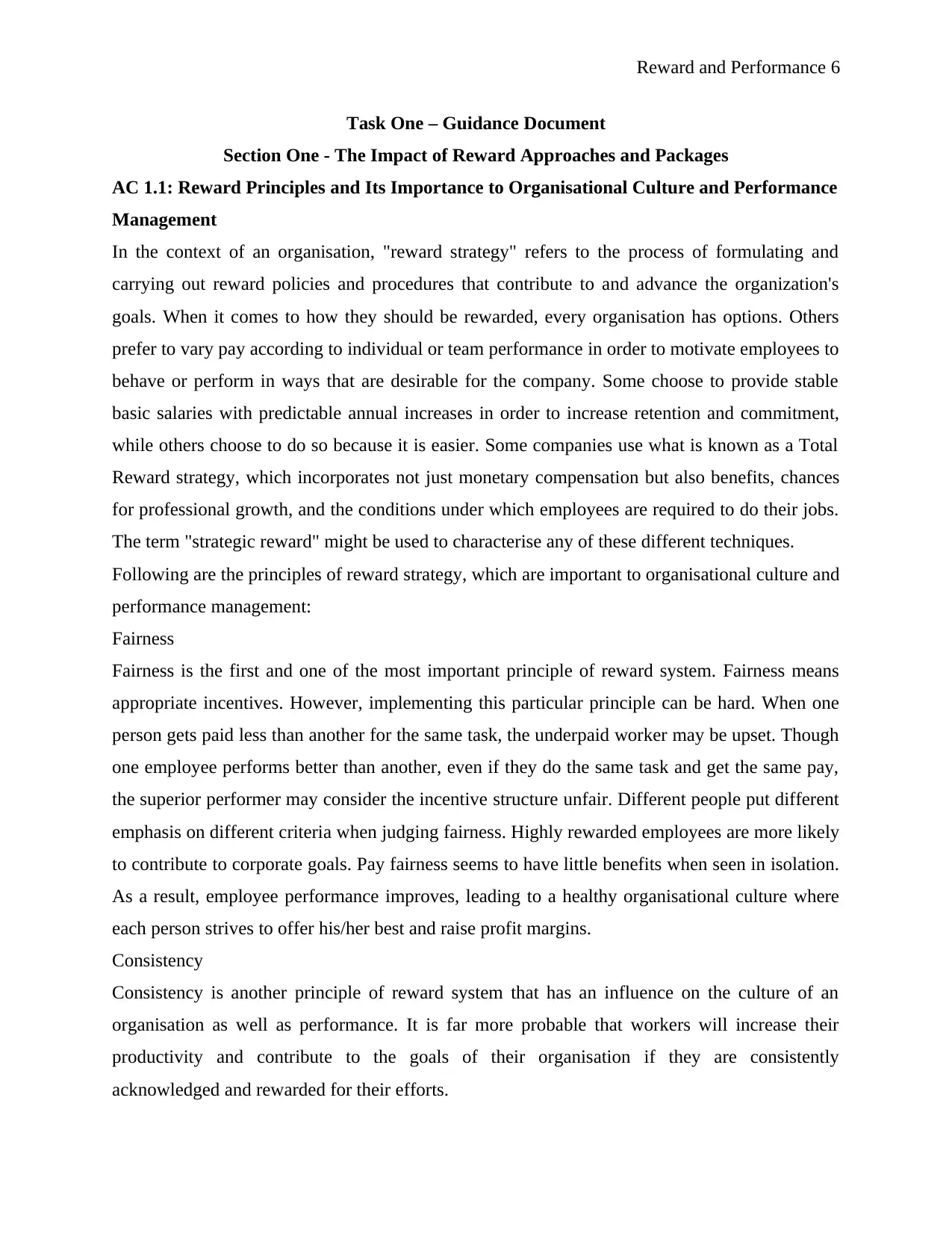
Reward and Performance 6
Task One – Guidance Document
Section One - The Impact of Reward Approaches and Packages
AC 1.1: Reward Principles and Its Importance to Organisational Culture and Performance
Management
In the context of an organisation, "reward strategy" refers to the process of formulating and
carrying out reward policies and procedures that contribute to and advance the organization's
goals. When it comes to how they should be rewarded, every organisation has options. Others
prefer to vary pay according to individual or team performance in order to motivate employees to
behave or perform in ways that are desirable for the company. Some choose to provide stable
basic salaries with predictable annual increases in order to increase retention and commitment,
while others choose to do so because it is easier. Some companies use what is known as a Total
Reward strategy, which incorporates not just monetary compensation but also benefits, chances
for professional growth, and the conditions under which employees are required to do their jobs.
The term "strategic reward" might be used to characterise any of these different techniques.
Following are the principles of reward strategy, which are important to organisational culture and
performance management:
Fairness
Fairness is the first and one of the most important principle of reward system. Fairness means
appropriate incentives. However, implementing this particular principle can be hard. When one
person gets paid less than another for the same task, the underpaid worker may be upset. Though
one employee performs better than another, even if they do the same task and get the same pay,
the superior performer may consider the incentive structure unfair. Different people put different
emphasis on different criteria when judging fairness. Highly rewarded employees are more likely
to contribute to corporate goals. Pay fairness seems to have little benefits when seen in isolation.
As a result, employee performance improves, leading to a healthy organisational culture where
each person strives to offer his/her best and raise profit margins.
Consistency
Consistency is another principle of reward system that has an influence on the culture of an
organisation as well as performance. It is far more probable that workers will increase their
productivity and contribute to the goals of their organisation if they are consistently
acknowledged and rewarded for their efforts.
Task One – Guidance Document
Section One - The Impact of Reward Approaches and Packages
AC 1.1: Reward Principles and Its Importance to Organisational Culture and Performance
Management
In the context of an organisation, "reward strategy" refers to the process of formulating and
carrying out reward policies and procedures that contribute to and advance the organization's
goals. When it comes to how they should be rewarded, every organisation has options. Others
prefer to vary pay according to individual or team performance in order to motivate employees to
behave or perform in ways that are desirable for the company. Some choose to provide stable
basic salaries with predictable annual increases in order to increase retention and commitment,
while others choose to do so because it is easier. Some companies use what is known as a Total
Reward strategy, which incorporates not just monetary compensation but also benefits, chances
for professional growth, and the conditions under which employees are required to do their jobs.
The term "strategic reward" might be used to characterise any of these different techniques.
Following are the principles of reward strategy, which are important to organisational culture and
performance management:
Fairness
Fairness is the first and one of the most important principle of reward system. Fairness means
appropriate incentives. However, implementing this particular principle can be hard. When one
person gets paid less than another for the same task, the underpaid worker may be upset. Though
one employee performs better than another, even if they do the same task and get the same pay,
the superior performer may consider the incentive structure unfair. Different people put different
emphasis on different criteria when judging fairness. Highly rewarded employees are more likely
to contribute to corporate goals. Pay fairness seems to have little benefits when seen in isolation.
As a result, employee performance improves, leading to a healthy organisational culture where
each person strives to offer his/her best and raise profit margins.
Consistency
Consistency is another principle of reward system that has an influence on the culture of an
organisation as well as performance. It is far more probable that workers will increase their
productivity and contribute to the goals of their organisation if they are consistently
acknowledged and rewarded for their efforts.
⊘ This is a preview!⊘
Do you want full access?
Subscribe today to unlock all pages.

Trusted by 1+ million students worldwide
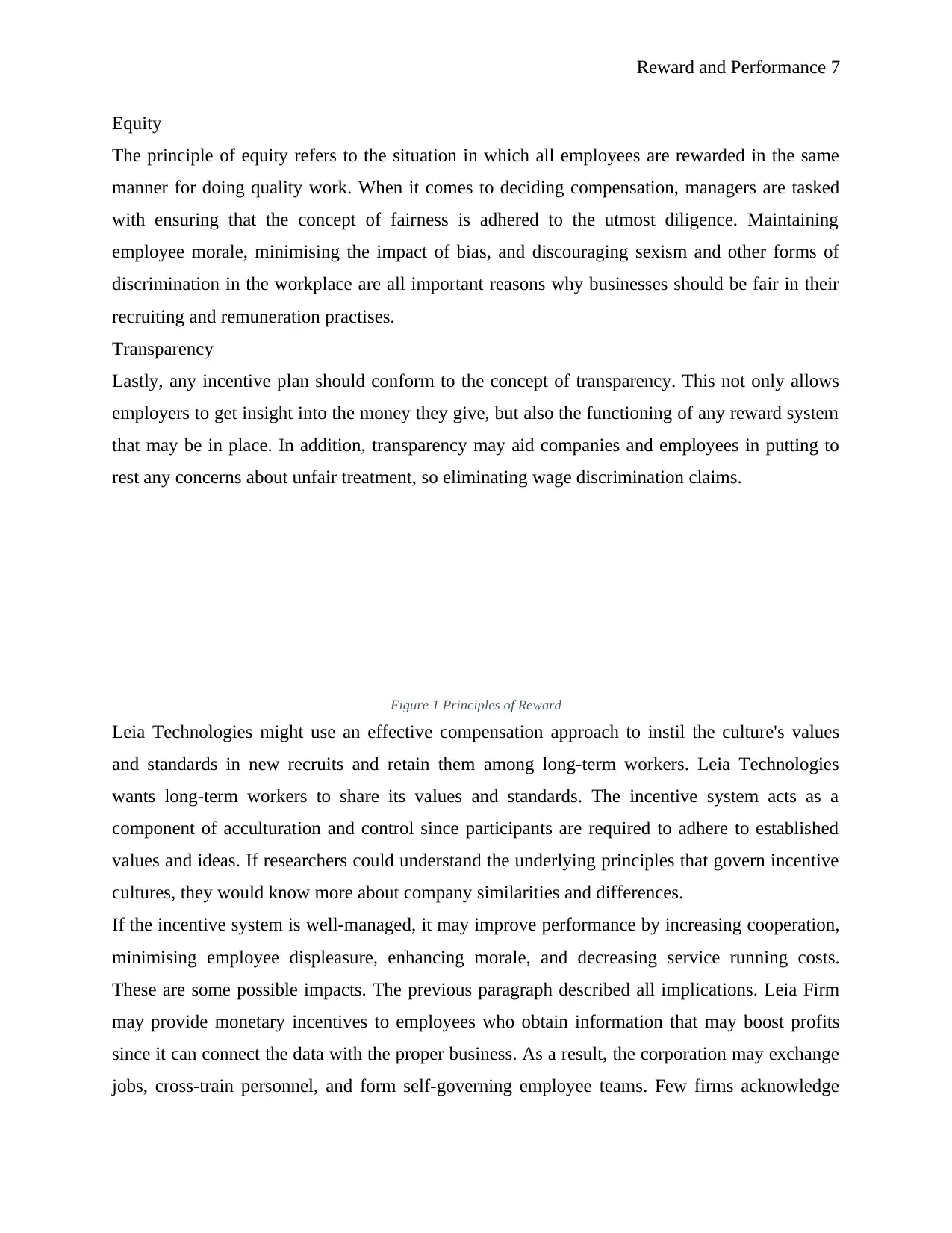
Reward and Performance 7
Equity
The principle of equity refers to the situation in which all employees are rewarded in the same
manner for doing quality work. When it comes to deciding compensation, managers are tasked
with ensuring that the concept of fairness is adhered to the utmost diligence. Maintaining
employee morale, minimising the impact of bias, and discouraging sexism and other forms of
discrimination in the workplace are all important reasons why businesses should be fair in their
recruiting and remuneration practises.
Transparency
Lastly, any incentive plan should conform to the concept of transparency. This not only allows
employers to get insight into the money they give, but also the functioning of any reward system
that may be in place. In addition, transparency may aid companies and employees in putting to
rest any concerns about unfair treatment, so eliminating wage discrimination claims.
Figure 1 Principles of Reward
Leia Technologies might use an effective compensation approach to instil the culture's values
and standards in new recruits and retain them among long-term workers. Leia Technologies
wants long-term workers to share its values and standards. The incentive system acts as a
component of acculturation and control since participants are required to adhere to established
values and ideas. If researchers could understand the underlying principles that govern incentive
cultures, they would know more about company similarities and differences.
If the incentive system is well-managed, it may improve performance by increasing cooperation,
minimising employee displeasure, enhancing morale, and decreasing service running costs.
These are some possible impacts. The previous paragraph described all implications. Leia Firm
may provide monetary incentives to employees who obtain information that may boost profits
since it can connect the data with the proper business. As a result, the corporation may exchange
jobs, cross-train personnel, and form self-governing employee teams. Few firms acknowledge
FairnessConsistencyEquityTransparency
Equity
The principle of equity refers to the situation in which all employees are rewarded in the same
manner for doing quality work. When it comes to deciding compensation, managers are tasked
with ensuring that the concept of fairness is adhered to the utmost diligence. Maintaining
employee morale, minimising the impact of bias, and discouraging sexism and other forms of
discrimination in the workplace are all important reasons why businesses should be fair in their
recruiting and remuneration practises.
Transparency
Lastly, any incentive plan should conform to the concept of transparency. This not only allows
employers to get insight into the money they give, but also the functioning of any reward system
that may be in place. In addition, transparency may aid companies and employees in putting to
rest any concerns about unfair treatment, so eliminating wage discrimination claims.
Figure 1 Principles of Reward
Leia Technologies might use an effective compensation approach to instil the culture's values
and standards in new recruits and retain them among long-term workers. Leia Technologies
wants long-term workers to share its values and standards. The incentive system acts as a
component of acculturation and control since participants are required to adhere to established
values and ideas. If researchers could understand the underlying principles that govern incentive
cultures, they would know more about company similarities and differences.
If the incentive system is well-managed, it may improve performance by increasing cooperation,
minimising employee displeasure, enhancing morale, and decreasing service running costs.
These are some possible impacts. The previous paragraph described all implications. Leia Firm
may provide monetary incentives to employees who obtain information that may boost profits
since it can connect the data with the proper business. As a result, the corporation may exchange
jobs, cross-train personnel, and form self-governing employee teams. Few firms acknowledge
FairnessConsistencyEquityTransparency
Paraphrase This Document
Need a fresh take? Get an instant paraphrase of this document with our AI Paraphraser
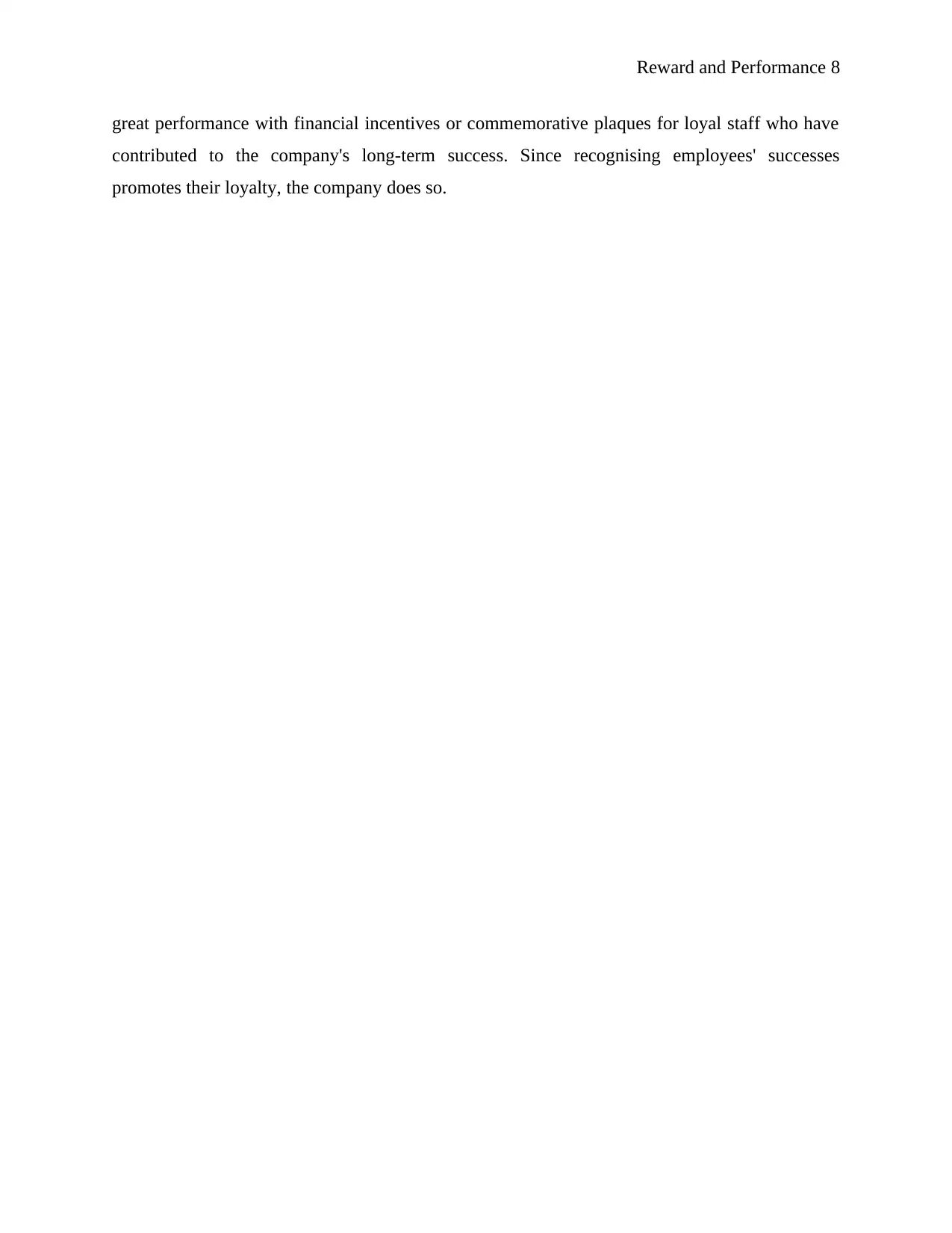
Reward and Performance 8
great performance with financial incentives or commemorative plaques for loyal staff who have
contributed to the company's long-term success. Since recognising employees' successes
promotes their loyalty, the company does so.
great performance with financial incentives or commemorative plaques for loyal staff who have
contributed to the company's long-term success. Since recognising employees' successes
promotes their loyalty, the company does so.
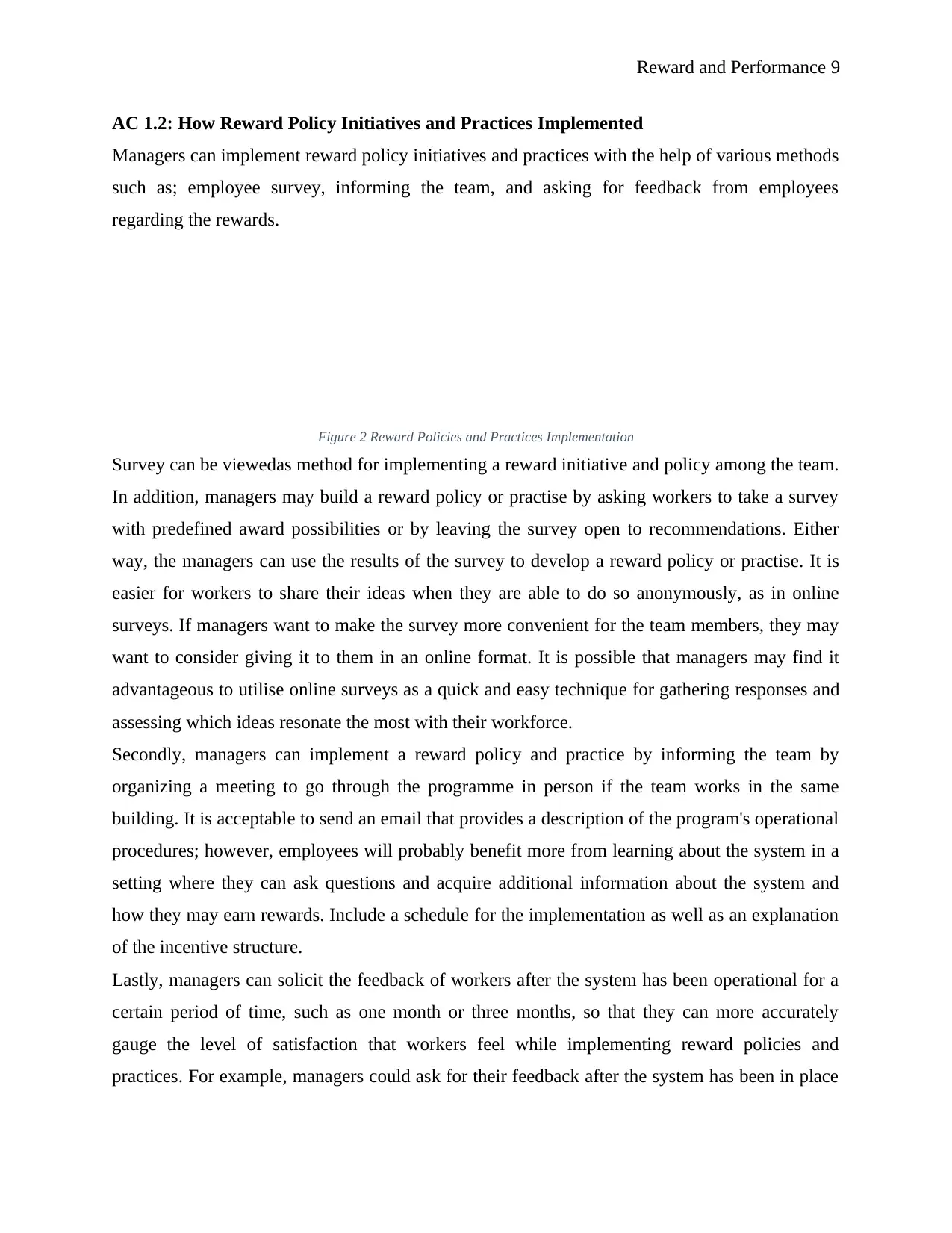
Reward and Performance 9
AC 1.2: How Reward Policy Initiatives and Practices Implemented
Managers can implement reward policy initiatives and practices with the help of various methods
such as; employee survey, informing the team, and asking for feedback from employees
regarding the rewards.
Figure 2 Reward Policies and Practices Implementation
Survey can be viewedas method for implementing a reward initiative and policy among the team.
In addition, managers may build a reward policy or practise by asking workers to take a survey
with predefined award possibilities or by leaving the survey open to recommendations. Either
way, the managers can use the results of the survey to develop a reward policy or practise. It is
easier for workers to share their ideas when they are able to do so anonymously, as in online
surveys. If managers want to make the survey more convenient for the team members, they may
want to consider giving it to them in an online format. It is possible that managers may find it
advantageous to utilise online surveys as a quick and easy technique for gathering responses and
assessing which ideas resonate the most with their workforce.
Secondly, managers can implement a reward policy and practice by informing the team by
organizing a meeting to go through the programme in person if the team works in the same
building. It is acceptable to send an email that provides a description of the program's operational
procedures; however, employees will probably benefit more from learning about the system in a
setting where they can ask questions and acquire additional information about the system and
how they may earn rewards. Include a schedule for the implementation as well as an explanation
of the incentive structure.
Lastly, managers can solicit the feedback of workers after the system has been operational for a
certain period of time, such as one month or three months, so that they can more accurately
gauge the level of satisfaction that workers feel while implementing reward policies and
practices. For example, managers could ask for their feedback after the system has been in place
EmployeeSurveyInformingTeamAskingforFeedback
AC 1.2: How Reward Policy Initiatives and Practices Implemented
Managers can implement reward policy initiatives and practices with the help of various methods
such as; employee survey, informing the team, and asking for feedback from employees
regarding the rewards.
Figure 2 Reward Policies and Practices Implementation
Survey can be viewedas method for implementing a reward initiative and policy among the team.
In addition, managers may build a reward policy or practise by asking workers to take a survey
with predefined award possibilities or by leaving the survey open to recommendations. Either
way, the managers can use the results of the survey to develop a reward policy or practise. It is
easier for workers to share their ideas when they are able to do so anonymously, as in online
surveys. If managers want to make the survey more convenient for the team members, they may
want to consider giving it to them in an online format. It is possible that managers may find it
advantageous to utilise online surveys as a quick and easy technique for gathering responses and
assessing which ideas resonate the most with their workforce.
Secondly, managers can implement a reward policy and practice by informing the team by
organizing a meeting to go through the programme in person if the team works in the same
building. It is acceptable to send an email that provides a description of the program's operational
procedures; however, employees will probably benefit more from learning about the system in a
setting where they can ask questions and acquire additional information about the system and
how they may earn rewards. Include a schedule for the implementation as well as an explanation
of the incentive structure.
Lastly, managers can solicit the feedback of workers after the system has been operational for a
certain period of time, such as one month or three months, so that they can more accurately
gauge the level of satisfaction that workers feel while implementing reward policies and
practices. For example, managers could ask for their feedback after the system has been in place
EmployeeSurveyInformingTeamAskingforFeedback
⊘ This is a preview!⊘
Do you want full access?
Subscribe today to unlock all pages.

Trusted by 1+ million students worldwide
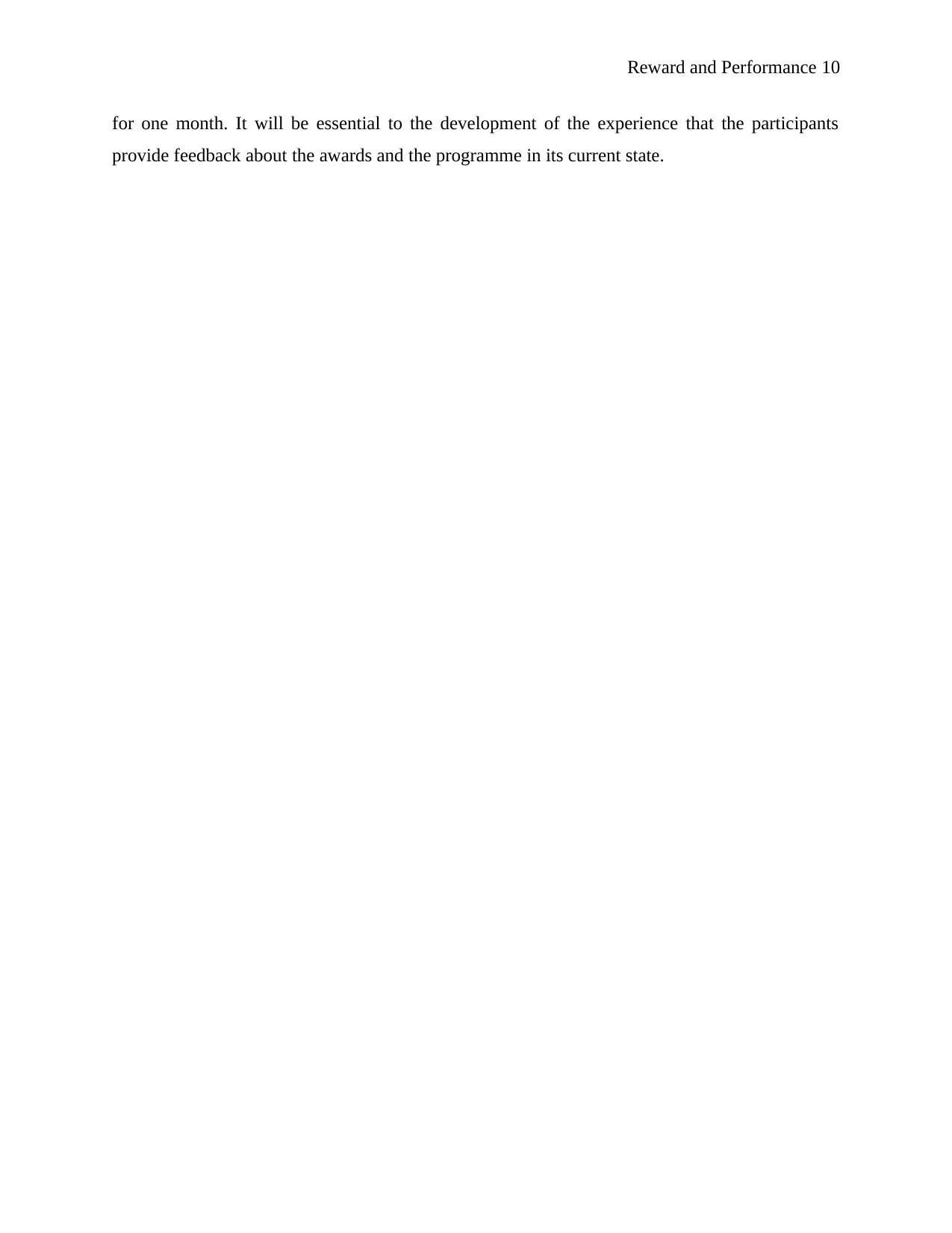
Reward and Performance 10
for one month. It will be essential to the development of the experience that the participants
provide feedback about the awards and the programme in its current state.
for one month. It will be essential to the development of the experience that the participants
provide feedback about the awards and the programme in its current state.
Paraphrase This Document
Need a fresh take? Get an instant paraphrase of this document with our AI Paraphraser
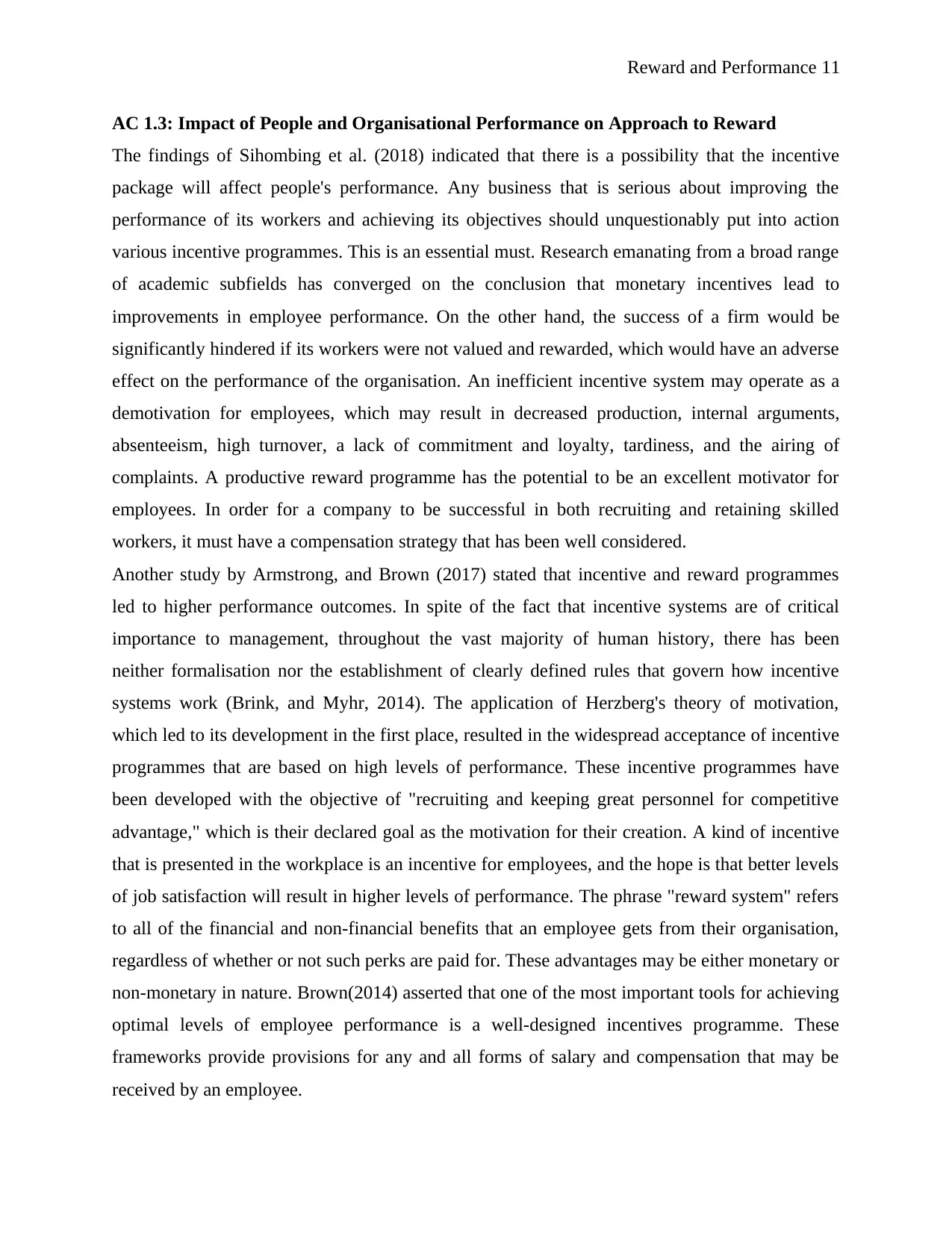
Reward and Performance 11
AC 1.3: Impact of People and Organisational Performance on Approach to Reward
The findings of Sihombing et al. (2018) indicated that there is a possibility that the incentive
package will affect people's performance. Any business that is serious about improving the
performance of its workers and achieving its objectives should unquestionably put into action
various incentive programmes. This is an essential must. Research emanating from a broad range
of academic subfields has converged on the conclusion that monetary incentives lead to
improvements in employee performance. On the other hand, the success of a firm would be
significantly hindered if its workers were not valued and rewarded, which would have an adverse
effect on the performance of the organisation. An inefficient incentive system may operate as a
demotivation for employees, which may result in decreased production, internal arguments,
absenteeism, high turnover, a lack of commitment and loyalty, tardiness, and the airing of
complaints. A productive reward programme has the potential to be an excellent motivator for
employees. In order for a company to be successful in both recruiting and retaining skilled
workers, it must have a compensation strategy that has been well considered.
Another study by Armstrong, and Brown (2017) stated that incentive and reward programmes
led to higher performance outcomes. In spite of the fact that incentive systems are of critical
importance to management, throughout the vast majority of human history, there has been
neither formalisation nor the establishment of clearly defined rules that govern how incentive
systems work (Brink, and Myhr, 2014). The application of Herzberg's theory of motivation,
which led to its development in the first place, resulted in the widespread acceptance of incentive
programmes that are based on high levels of performance. These incentive programmes have
been developed with the objective of "recruiting and keeping great personnel for competitive
advantage," which is their declared goal as the motivation for their creation. A kind of incentive
that is presented in the workplace is an incentive for employees, and the hope is that better levels
of job satisfaction will result in higher levels of performance. The phrase "reward system" refers
to all of the financial and non-financial benefits that an employee gets from their organisation,
regardless of whether or not such perks are paid for. These advantages may be either monetary or
non-monetary in nature. Brown(2014) asserted that one of the most important tools for achieving
optimal levels of employee performance is a well-designed incentives programme. These
frameworks provide provisions for any and all forms of salary and compensation that may be
received by an employee.
AC 1.3: Impact of People and Organisational Performance on Approach to Reward
The findings of Sihombing et al. (2018) indicated that there is a possibility that the incentive
package will affect people's performance. Any business that is serious about improving the
performance of its workers and achieving its objectives should unquestionably put into action
various incentive programmes. This is an essential must. Research emanating from a broad range
of academic subfields has converged on the conclusion that monetary incentives lead to
improvements in employee performance. On the other hand, the success of a firm would be
significantly hindered if its workers were not valued and rewarded, which would have an adverse
effect on the performance of the organisation. An inefficient incentive system may operate as a
demotivation for employees, which may result in decreased production, internal arguments,
absenteeism, high turnover, a lack of commitment and loyalty, tardiness, and the airing of
complaints. A productive reward programme has the potential to be an excellent motivator for
employees. In order for a company to be successful in both recruiting and retaining skilled
workers, it must have a compensation strategy that has been well considered.
Another study by Armstrong, and Brown (2017) stated that incentive and reward programmes
led to higher performance outcomes. In spite of the fact that incentive systems are of critical
importance to management, throughout the vast majority of human history, there has been
neither formalisation nor the establishment of clearly defined rules that govern how incentive
systems work (Brink, and Myhr, 2014). The application of Herzberg's theory of motivation,
which led to its development in the first place, resulted in the widespread acceptance of incentive
programmes that are based on high levels of performance. These incentive programmes have
been developed with the objective of "recruiting and keeping great personnel for competitive
advantage," which is their declared goal as the motivation for their creation. A kind of incentive
that is presented in the workplace is an incentive for employees, and the hope is that better levels
of job satisfaction will result in higher levels of performance. The phrase "reward system" refers
to all of the financial and non-financial benefits that an employee gets from their organisation,
regardless of whether or not such perks are paid for. These advantages may be either monetary or
non-monetary in nature. Brown(2014) asserted that one of the most important tools for achieving
optimal levels of employee performance is a well-designed incentives programme. These
frameworks provide provisions for any and all forms of salary and compensation that may be
received by an employee.
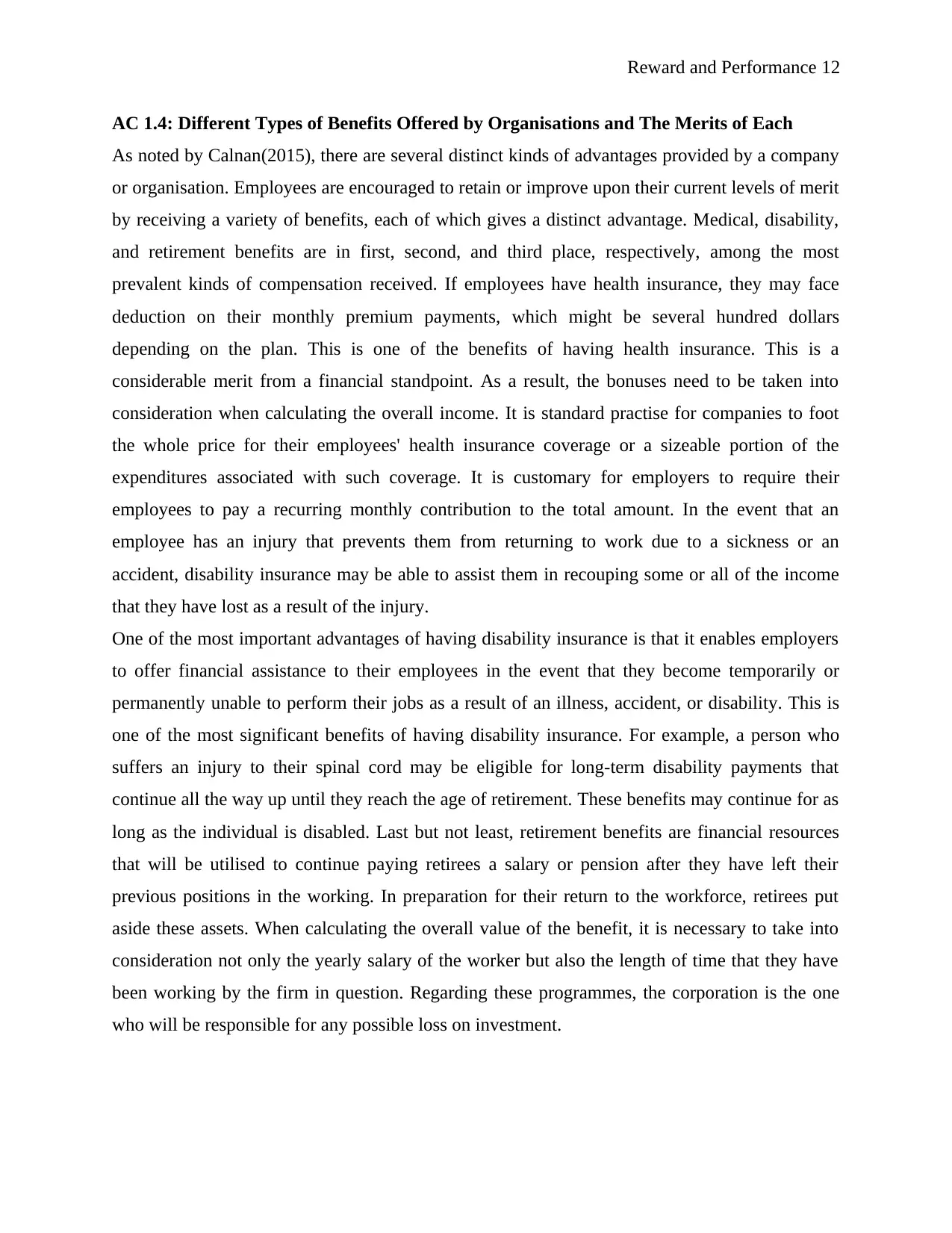
Reward and Performance 12
AC 1.4: Different Types of Benefits Offered by Organisations and The Merits of Each
As noted by Calnan(2015), there are several distinct kinds of advantages provided by a company
or organisation. Employees are encouraged to retain or improve upon their current levels of merit
by receiving a variety of benefits, each of which gives a distinct advantage. Medical, disability,
and retirement benefits are in first, second, and third place, respectively, among the most
prevalent kinds of compensation received. If employees have health insurance, they may face
deduction on their monthly premium payments, which might be several hundred dollars
depending on the plan. This is one of the benefits of having health insurance. This is a
considerable merit from a financial standpoint. As a result, the bonuses need to be taken into
consideration when calculating the overall income. It is standard practise for companies to foot
the whole price for their employees' health insurance coverage or a sizeable portion of the
expenditures associated with such coverage. It is customary for employers to require their
employees to pay a recurring monthly contribution to the total amount. In the event that an
employee has an injury that prevents them from returning to work due to a sickness or an
accident, disability insurance may be able to assist them in recouping some or all of the income
that they have lost as a result of the injury.
One of the most important advantages of having disability insurance is that it enables employers
to offer financial assistance to their employees in the event that they become temporarily or
permanently unable to perform their jobs as a result of an illness, accident, or disability. This is
one of the most significant benefits of having disability insurance. For example, a person who
suffers an injury to their spinal cord may be eligible for long-term disability payments that
continue all the way up until they reach the age of retirement. These benefits may continue for as
long as the individual is disabled. Last but not least, retirement benefits are financial resources
that will be utilised to continue paying retirees a salary or pension after they have left their
previous positions in the working. In preparation for their return to the workforce, retirees put
aside these assets. When calculating the overall value of the benefit, it is necessary to take into
consideration not only the yearly salary of the worker but also the length of time that they have
been working by the firm in question. Regarding these programmes, the corporation is the one
who will be responsible for any possible loss on investment.
AC 1.4: Different Types of Benefits Offered by Organisations and The Merits of Each
As noted by Calnan(2015), there are several distinct kinds of advantages provided by a company
or organisation. Employees are encouraged to retain or improve upon their current levels of merit
by receiving a variety of benefits, each of which gives a distinct advantage. Medical, disability,
and retirement benefits are in first, second, and third place, respectively, among the most
prevalent kinds of compensation received. If employees have health insurance, they may face
deduction on their monthly premium payments, which might be several hundred dollars
depending on the plan. This is one of the benefits of having health insurance. This is a
considerable merit from a financial standpoint. As a result, the bonuses need to be taken into
consideration when calculating the overall income. It is standard practise for companies to foot
the whole price for their employees' health insurance coverage or a sizeable portion of the
expenditures associated with such coverage. It is customary for employers to require their
employees to pay a recurring monthly contribution to the total amount. In the event that an
employee has an injury that prevents them from returning to work due to a sickness or an
accident, disability insurance may be able to assist them in recouping some or all of the income
that they have lost as a result of the injury.
One of the most important advantages of having disability insurance is that it enables employers
to offer financial assistance to their employees in the event that they become temporarily or
permanently unable to perform their jobs as a result of an illness, accident, or disability. This is
one of the most significant benefits of having disability insurance. For example, a person who
suffers an injury to their spinal cord may be eligible for long-term disability payments that
continue all the way up until they reach the age of retirement. These benefits may continue for as
long as the individual is disabled. Last but not least, retirement benefits are financial resources
that will be utilised to continue paying retirees a salary or pension after they have left their
previous positions in the working. In preparation for their return to the workforce, retirees put
aside these assets. When calculating the overall value of the benefit, it is necessary to take into
consideration not only the yearly salary of the worker but also the length of time that they have
been working by the firm in question. Regarding these programmes, the corporation is the one
who will be responsible for any possible loss on investment.
⊘ This is a preview!⊘
Do you want full access?
Subscribe today to unlock all pages.

Trusted by 1+ million students worldwide
1 out of 25
Related Documents
Your All-in-One AI-Powered Toolkit for Academic Success.
+13062052269
info@desklib.com
Available 24*7 on WhatsApp / Email
![[object Object]](/_next/static/media/star-bottom.7253800d.svg)
Unlock your academic potential
Copyright © 2020–2025 A2Z Services. All Rights Reserved. Developed and managed by ZUCOL.




